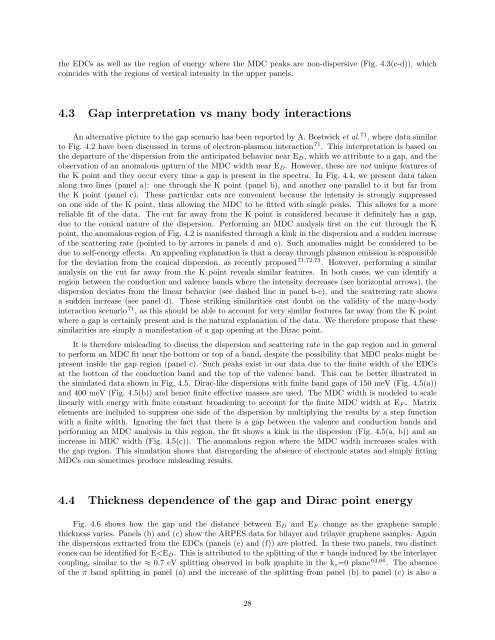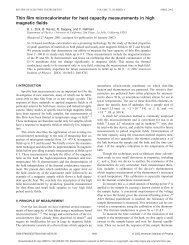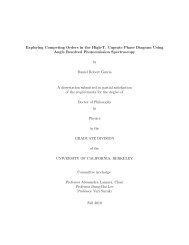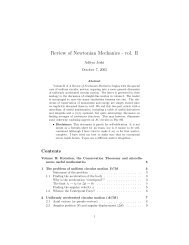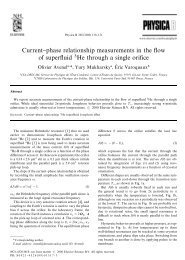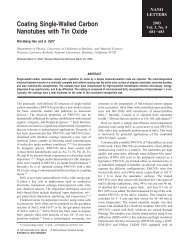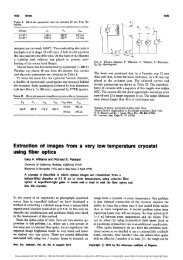Dirac Fermions in Graphene and Graphiteâa view from angle ...
Dirac Fermions in Graphene and Graphiteâa view from angle ...
Dirac Fermions in Graphene and Graphiteâa view from angle ...
You also want an ePaper? Increase the reach of your titles
YUMPU automatically turns print PDFs into web optimized ePapers that Google loves.
the EDCs as well as the region of energy where the MDC peaks are non-dispersive (Fig. 4.3(c-d)), which<br />
co<strong>in</strong>cides with the regions of vertical <strong>in</strong>tensity <strong>in</strong> the upper panels.<br />
4.3 Gap <strong>in</strong>terpretation vs many body <strong>in</strong>teractions<br />
An alternative picture to the gap scenario has been reported by A. Bostwick et al. 71 , where data similar<br />
to Fig. 4.2 have been discussed <strong>in</strong> terms of electron-plasmon <strong>in</strong>teraction 71 . This <strong>in</strong>terpretation is based on<br />
the departure of the dispersion <strong>from</strong> the anticipated behavior near E D , which we attribute to a gap, <strong>and</strong> the<br />
observation of an anomalous upturn of the MDC width near E D . However, these are not unique features of<br />
the K po<strong>in</strong>t <strong>and</strong> they occur every time a gap is present <strong>in</strong> the spectra. In Fig. 4.4, we present data taken<br />
along two l<strong>in</strong>es (panel a): one through the K po<strong>in</strong>t (panel b), <strong>and</strong> another one parallel to it but far <strong>from</strong><br />
the K po<strong>in</strong>t (panel c). These particular cuts are convenient because the <strong>in</strong>tensity is strongly suppressed<br />
on one side of the K po<strong>in</strong>t, thus allow<strong>in</strong>g the MDC to be fitted with s<strong>in</strong>gle peaks. This allows for a more<br />
reliable fit of the data. The cut far away <strong>from</strong> the K po<strong>in</strong>t is considered because it def<strong>in</strong>itely has a gap,<br />
due to the conical nature of the dispersion. Perform<strong>in</strong>g an MDC analysis first on the cut through the K<br />
po<strong>in</strong>t, the anomalous region of Fig. 4.2 is manifested through a k<strong>in</strong>k <strong>in</strong> the dispersion <strong>and</strong> a sudden <strong>in</strong>crease<br />
of the scatter<strong>in</strong>g rate (po<strong>in</strong>ted to by arrows <strong>in</strong> panels d <strong>and</strong> e). Such anomalies might be considered to be<br />
due to self-energy effects. An appeal<strong>in</strong>g explanation is that a decay through plasmon emission is responsible<br />
for the deviation <strong>from</strong> the conical dispersion, as recently proposed 71,72,73 . However, perform<strong>in</strong>g a similar<br />
analysis on the cut far away <strong>from</strong> the K po<strong>in</strong>t reveals similar features. In both cases, we can identify a<br />
region between the conduction <strong>and</strong> valence b<strong>and</strong>s where the <strong>in</strong>tensity decreases (see horizontal arrows), the<br />
dispersion deviates <strong>from</strong> the l<strong>in</strong>ear behavior (see dashed l<strong>in</strong>e <strong>in</strong> panel b-c), <strong>and</strong> the scatter<strong>in</strong>g rate shows<br />
a sudden <strong>in</strong>crease (see panel d). These strik<strong>in</strong>g similarities cast doubt on the validity of the many-body<br />
<strong>in</strong>teraction scenario 71 , as this should be able to account for very similar features far away <strong>from</strong> the K po<strong>in</strong>t<br />
where a gap is certa<strong>in</strong>ly present <strong>and</strong> is the natural explanation of the data. We therefore propose that these<br />
similarities are simply a manifestation of a gap open<strong>in</strong>g at the <strong>Dirac</strong> po<strong>in</strong>t.<br />
It is therefore mislead<strong>in</strong>g to discuss the dispersion <strong>and</strong> scatter<strong>in</strong>g rate <strong>in</strong> the gap region <strong>and</strong> <strong>in</strong> general<br />
to perform an MDC fit near the bottom or top of a b<strong>and</strong>, despite the possibility that MDC peaks might be<br />
present <strong>in</strong>side the gap region (panel c). Such peaks exist <strong>in</strong> our data due to the f<strong>in</strong>ite width of the EDCs<br />
at the bottom of the conduction b<strong>and</strong> <strong>and</strong> the top of the valence b<strong>and</strong>. This can be better illustrated <strong>in</strong><br />
the simulated data shown <strong>in</strong> Fig. 4.5. <strong>Dirac</strong>-like dispersions with f<strong>in</strong>ite b<strong>and</strong> gaps of 150 meV (Fig. 4.5(a))<br />
<strong>and</strong> 400 meV (Fig. 4.5(b)) <strong>and</strong> hence f<strong>in</strong>ite effective masses are used. The MDC width is modeled to scale<br />
l<strong>in</strong>early with energy with f<strong>in</strong>ite constant broaden<strong>in</strong>g to account for the f<strong>in</strong>ite MDC width at E F . Matrix<br />
elements are <strong>in</strong>cluded to suppress one side of the dispersion by multiply<strong>in</strong>g the results by a step function<br />
with a f<strong>in</strong>ite width. Ignor<strong>in</strong>g the fact that there is a gap between the valence <strong>and</strong> conduction b<strong>and</strong>s <strong>and</strong><br />
perform<strong>in</strong>g an MDC analysis <strong>in</strong> this region, the fit shows a k<strong>in</strong>k <strong>in</strong> the dispersion (Fig. 4.5(a, b)) <strong>and</strong> an<br />
<strong>in</strong>crease <strong>in</strong> MDC width (Fig. 4.5(c)). The anomalous region where the MDC width <strong>in</strong>creases scales with<br />
the gap region. This simulation shows that disregard<strong>in</strong>g the absence of electronic states <strong>and</strong> simply fitt<strong>in</strong>g<br />
MDCs can sometimes produce mislead<strong>in</strong>g results.<br />
4.4 Thickness dependence of the gap <strong>and</strong> <strong>Dirac</strong> po<strong>in</strong>t energy<br />
Fig. 4.6 shows how the gap <strong>and</strong> the distance between E D <strong>and</strong> E F change as the graphene sample<br />
thickness varies. Panels (b) <strong>and</strong> (c) show the ARPES data for bilayer <strong>and</strong> trilayer graphene samples. Aga<strong>in</strong><br />
the dispersions extracted <strong>from</strong> the EDCs (panels (e) <strong>and</strong> (f)) are plotted. In these two panels, two dist<strong>in</strong>ct<br />
cones can be identified for E


